Plans for the Boltex Building and Belle Reve at Walker and Church
Developers have put a proposal together for the corner of Walker and Church, incorporating the taxpayer that is Belle Reve, #32, into the L-shaped building that is #34 and creating a new cast iron building. I will continue with the details below, but one thing confounds me: from what I can tell, 32 Walker has not changed hands since 1981; 34 Walker, acquired in 1966 by the family that ran the Paramount/Boltex Textile Company, has a contract signed according to the listing, but has not changed hands yet. So it seems a bit premature?
All that aside, it’s best to look at the massing drawing above to understand: the dark grey is the existing L-shaped Paramount/Boltex building, and the light gray is the new construction. The idea is to merge these two into a single cast iron project. They developers would add a sixth floor to the entire structure, which is within zoning limits, and that floor would get the crown that mimics the current one plus a glass penthouse set back from the street wall. The new structure would lose the fire escapes. The color would match 55 Reade, the cast iron building on the corner of Broadway.
The developers are Cedric Abboud and Gary Romaniello, and Abboud said he is very active in the UK doing historic restorations in Chelsea and Kensington as well as the Middle East, but this is only their our second year in the US as a developer. SOMA Architects, led by his brother, Michel Abboud, was the architect for the failed 45 Park Place — the supertall that is still left hanging and is, IMO, a blight on the neighborhood.
The new building would actually be cast in iron; the developers said they were meeting last week with the Alabama company Robinson Iron. And all of this is very preliminary: they have submitted a request for the application with Landmarks and have been assigned a staff member. But they wanted to come to CB1 early to get their feedback.
The committee thought it was a bit too early — they had a hard time digesting the plans without more detail. And no vote was taken. But there were some that were fully accepting of the plan, and thought that they were off to a good start, and some that thought it was too “Disney” (I don’t quite get that?) and didn’t delineate between the old structure and the new.
“If someone is willing to spent the money to make a beautiful cast iron on the corner, then generally I am in favor of that,” said chair Jason Friedman. “The true preservationist would say this is not a good idea.”
The Belle Reve building was built in 1954 — it is not protected by the historic district. The Boltex Building was built in 1868.
A woman representing Belle Reve said that demolishing the bar would be devastating for the neighborhood, especially just to build more expensive apartments. “Belle Reve brings so much life to that corner,” she said. “It would be very said to see it go.”
The developers said there was no reason the new building couldn’t have a bar in its storefronts.







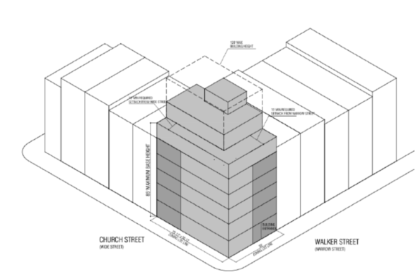
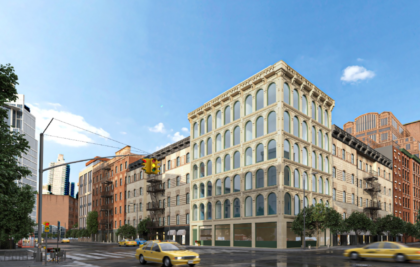
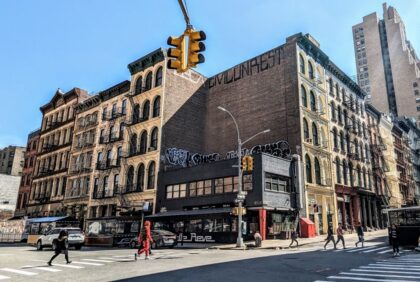
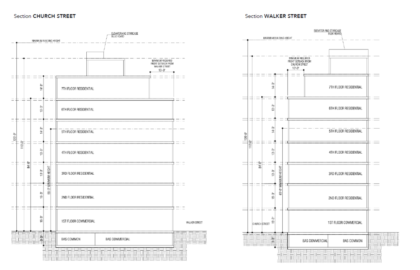
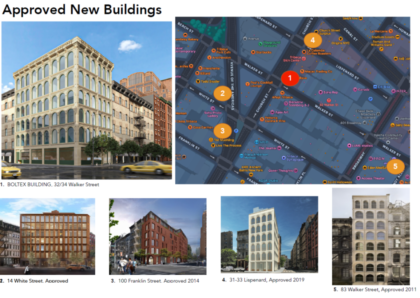









Looks great to me! Love the trees also in the rendering…if those are possible, given the common hollow sidewalks in the neighborhood. Really wish we could have more trees on the streets here.
As for the “Disney” comment, perhaps they mean this building is a kind of fauxthenticity? But then the alternative is to create a building in a contemporary style, which would not match the historic styles here, but at least can be designed to complement rather than combat the surrounding building styles.
Or maybe because they dropped the rendering in a totally made up scene that does not resemble the actual location in the slightest…
AI aside, I think this idea is actually a great solution of how to integrate the new section with the old. I wish more developers would be willing to think creatively, instead of letting an architect come up with a horrible “contextual” modern result. True it is not 100% original or historic, but visually it will be attractive & blend in better than most other ways additions have been built in the neighborhood. And there is historical precedent- read about the Powell Building for example. https://tribecacitizen.wpengine.com/the-history-of-tribeca-buildings/the-history-of-105-hudson
This: “to merge these two into a single cast iron project”
is a terrible idea. Historic preservation means that the two portions (old and new) should be readily distinguishable.
It would be sad to see Belle Rev go (or relocate), it’s one Tribeca’s best bars.
As for as the design goes, it’s a wasted opportunity to build much needed housing in this area. This location is incredibly central and transit rich with close proximity to good jobs and schools. If this city were ever serious about solving its housing crisis it would permit a 1000 unit building on this site.
Some people might say that’s “out of character” for the neighborhood, but it’s really not. There is a 550 foot building literally across the street. Tribeca is not a low rise neighborhood.
Instead with the proposed design we will get 6 or 7 very expensive units some of which will certainly not be a primary residence. That’s fine too, every dollar of tax revenue counts, but I would rather have the neighborhood with the 1000 units, with 20% affordable and a variety of size in the remaining. So just another policy failure by this city. Aggregate all these policy failures and it’s easy to understand we are in a housing crisis.
This is not a serious idea.
If you look at the “new” residential towers in the Tribeca area, you will see that they are built on huge footprints of required open space. This space is not available on this lot to comply with residential code.
The adaptive reuse of Tribeca lofts created pre-2010 for residential space came with substantial limitations recognizing that the normal residential codes could not be complied with here.
These include minimum sizes for individual lofts:
*Maximum 1 per floor in buildings with less than 2,000 square feet per floor
*Minimum 2,000 square feet in larger loft buildings, with some exceptions where more windows and rear yard space is available, even if not the typical 30-feet deep yard required for residential buildings and their light and air.
*The total number of loft apartments cannot be more than one per 1,000 square feet of total floor area allocated to loft apartments.
Love this. We need more infill that keeps the context of the neighborhood. I’m looking at you parking lots!
Exactly. Time for the open street-level parking lots to go. That eyesore of a public toilet, garbage dump, and counterfeit bazaar on Lispenard and Broadway should be the first to go.
It’s entirely possible to let the historic buildings stand on their own as true works of history; and design a tasteful infill that stands out as being of today, while permitting Belle Reve to continue in its location.
Couldn’t have agreed more.
In the once-thriving Tribeca, an iconic neighborhood steeped in art and filmmaking, the cruel encroachment of glass and steel behemoths casts a cold, unfeeling shadow over the lives of its middle-class artists. The New York Times reported that these foreign developers, seeking nothing more than a tax haven and a place to hide their assets, are driving out the very heart and soul of Tribeca. And with it goes Belle Reve, my beloved sanctuary, a rare affordable gem in a sea of exorbitant eateries, where creative minds gathered to share ideas and inspiration.
These monstrous, soulless structures not only stand in stark contrast to the rich cultural tapestry of the neighborhood, but also, like a plague, remain empty. Their absentee occupants, perhaps gracing the city with their presence once a year, contribute nothing to the local economy. The Wall Street Journal exposed the bizarre tax laws that only serve to benefit these wealthy, non-resident leeches.
The reckless proliferation of luxury skyscrapers and condominiums in the heart of New York City is, as Bloomberg reported, a potential catalyst for a catastrophic real estate bubble. The devastation is twofold: first, the relentless rise in property values and rents crushes the dreams of small businesses and middle-class denizens, tearing them from their homes and lives. In their wake, we are left with the hollow husks of once-beloved cultural institutions, vital to the fabric of our neighborhood.
As the middle-class artists and residents are forced out, they may find themselves unable to travel the ever-increasing distances back to the spaces they once called home. This could lead to a diaspora of talent, with creative communities becoming fragmented and dispersed. As neighborhoods lose their unique character, the very essence that once attracted filmmakers and television producers to Tribeca might begin to evaporate.
The loss of affordable creative spaces, as well as the departure of the artists who inhabited them, could have a chilling effect on the film and television industry’s desire to use Tribeca as a backdrop for future projects. The neighborhood’s rich history, as chronicled by The Village Voice, may no longer be enough to lure productions to the area, as the empty shells of luxury developments replace the vibrant street life and creative energy that once defined the neighborhood.
Second, as The Guardian has outlined, this gluttonous construction feeds a bubble that inflates property values beyond any connection to the local economy’s fundamentals, like job growth and income levels. Should the bubble burst, we’ll see a rapid decline in property values, destabilizing the entire local real estate market, with far-reaching consequences for the city as a whole.
In their blind quest for profits, these luxury developments ravage our city’s cultural and economic diversity, exacerbate income inequality, and risk financial collapse. It is paramount for local policymakers to take heed, acknowledge the potential impact of new development on the community, and implement policies that foster a more equitable and sustainable urban environment, before the city we love is lost to the sterile grasp of foreign investors.
Now is the time for New York City to reevaluate its priorities and protect the very heart and soul that makes it a cultural mecca. The city’s policymakers must act swiftly to preserve the essence of neighborhoods like Tribeca, safeguarding the future of the creative communities that call it home, lest we stand witness to the tragic demise of the very soul of the city.
Belle Reve is undoubtedly the best bar in Tribeca – seeing it go for some monstrosity of a building would be a dagger to our neighborhood’s soul. Belle Reve is constantly teeming with patrons from open to close and livens their corner like no other bar could. I stand with Belle Reve wholeheartedly.
It would be sad to see Belle Reve go. Fun spot and great music. Sometimes even cool live bands in there.
I hope they can survive somehow, whether re-appearing like a Phoenix at this same location, or somewhere nearby but still in our Tribeca neighborhood.